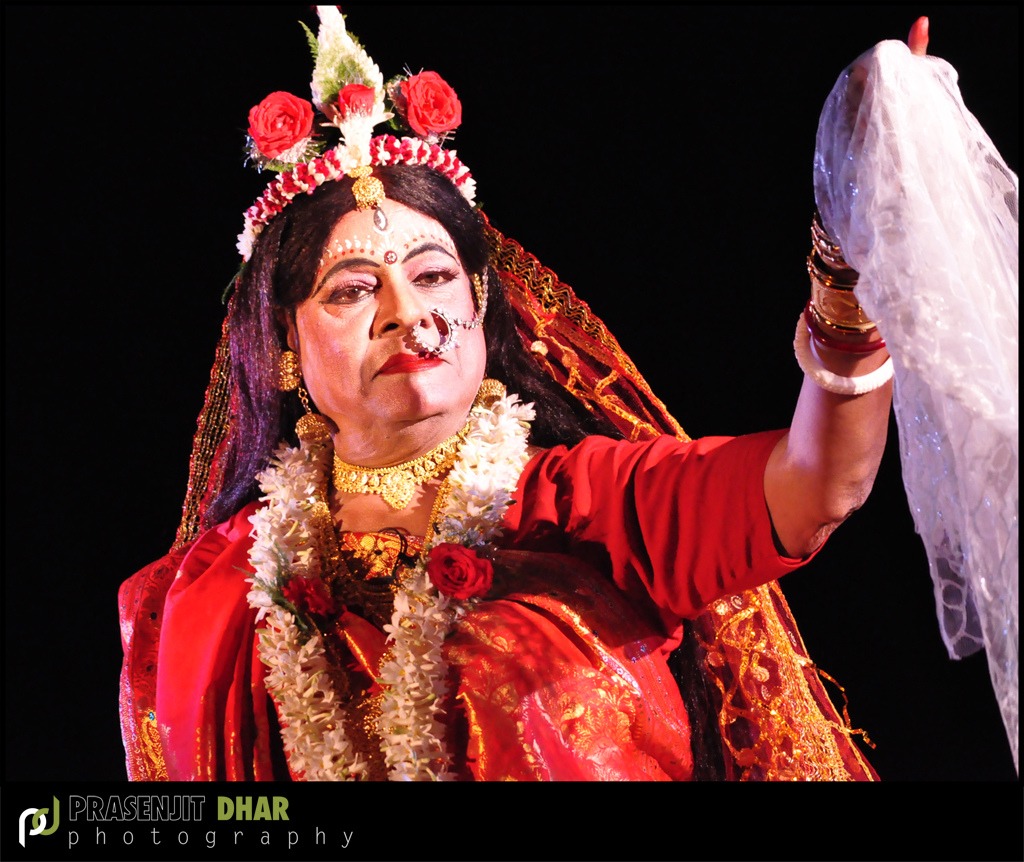Ardhanareshwara the awesome image of Lord Shiva in Hinduism blends purusha or male and prakriti or female essence almost nullifying the worldly distinction of man and woman. Shiva is also popularly known as Nataraja, the lord of dance. This implies that Shiva’s image of a dancer accompanies the masculine and feminine union denoted in his figure of the ardhanareshwara and touts dance as the means of erasing the distinction between a man and a woman. Dance is the representative of performing arts and therefore this bears the connotation that a performing artist is entitled to unite the masculine and feminine tatva or the elements in his performance without hesitation or concerns about the earthly male-female distinction. It is observed that some singers often modulate their voice and sing in female and/or male voice. A classical dancer whether a man or a woman portrays the characteristics of either sex unhesitatingly while one dances. For instance, as a Bharatnatyam dancer, I had learnt to perform dual characters Rama and Sita during my dance enactment of the episode of Sita harana or the abduction of Sita from the Ramayana. It is fact not unknown that many folk dances also include Veshabhusha forms in which men and women freely interchange the roles of either sex.
In India, this tradition of role swapping by men and women in performing arts traces its origin in its primordial religious history. Two famous Indian Gods namely; Vishnu and Shiva are adored in their feminine incarnations as Mohini and Gopishwara. The adoption of feminine forms by these male gods is certainly the testimony of the fact that Indian tradition has given the privilege of effacing the Man- Woman distinction postulated by conventional ideology. This fact candidly negates male preponderance promoted diligently by patriarchy in the country wherein traditionalism segregates woman as the “weaker sex” in spite of adulating the feminine deities like Durga, Kali and laxmi etc. The documentary film Chena Kintu Ajana written and produced by Debojit Majumder and directed by Dipanker Dutta (Bengali with English subtitles, 2014) retrieves for us the memories of this primeval Indian artistic tradition representative of the sexless divinity embodied in Shiva’s Ardhanareshwara image. The documentary is also the most admirable evidence of the manner in which an art form can be the means of undermining gender bias in the society postulated by the proponents of the male dominated world.
The film is apparently on the last generation of female impersonators popularly known as “Ranis” in the early jatra. Dr. Ananda Lal’s informative commentary on the inception of Jatra to its development and its present state makes it a fact based analysis of this pristine folk art of Bengal. Moreover, the detailed recapitulation by educationists and jatra experts regarding the extraordinary talent of these jatra performers who put their heart and soul in their work almost to the extent of making the spectators believe they were not men but women performing on the stage is extremely arresting. On the whole, the film provides us every means to recognize the knack of the performers overlooking the reality that they adopted the profession mainly for earning money. The hard-work and indefatigable dedication with which these actors had pursued their acting is described in a commendable mode which motivates us to not only adore but also respect these forgotten actors who are otherwise known to us. In this way, Chena Kintu Ajana or Known strangers justifies its title commendably. The reminiscences of Natta Company Owner Makhan Natta who had the opportunity to work with these performers gives us an idea of the indelible impression these artists have left on his mind that provokes him to say, “I miss my Ranis”. The film closes with the disclosure of the pathos of the family members of these artists in the present times as the decline in the demands of the performers in Jatra with the entry of the female actors led to a depletion in the number of the female impersonators wherein some of them took to menial jobs which brought them no economic boost and those unable to take up any other work apart from their profession committed suicide. However, the film ends optimistically by bringing Satabala Rani’s (One of the surviving performing artists that was interviewed by the makers of the film before his death) prayer for the well-being of the entire humanity and his disciple Bobby’s inspiring performance as goddess Jagadatri the mother of the universe. All in all, Chena is a film made with a clean and focused perspective to illustrate the unparalleled contribution of the female impersonators in the early jatra. However, the documentary becomes a distinctive attempt in the realm of entertainment as it manages to attest the irrelevance in the consideration of the masculine and feminine divide which governs most of our understanding about the world based on the foundation of binary opposites.
Chena establishes for us, the fine and beautiful male presenters who appeared more feminine than actual women the reason being that they were dexterous in their minute observations of female characteristics like “a woman puts her left foot forward first while walking”. However, Unlike the delicacy and charm these male actors convincingly projected which provoked the male audience members to abduct them at times mistaking them as women, the makers of the film have carefully chosen episodes from Indian Mythology which dismantle the preconditioned image of women as docile and submissive and project them as intrepid fighters of male preponderance in the society. On the one hand, we see performers like Chapal da or Chapal Rani as Kaikai defending her act of sending Rama to exile most dauntingly and on the other hand we see Janardan da or Janardan Rani as Mandodari strongly confronting her husband Ravana while audaciously trying to free Rama’s wife Sita from his bondage. This pleasing paradox motivates us to praise the humility with which these male actors adopted female roles that acknowledge the latent feminine power concealed within its apparent delicacy. A woman resisting the onslaught of patriarchy becomes the cynosure of almost all the intermittent performances by the actors that we witness throughout the documentary. This enables us to realize that Chena is not just another appraisal on the art of female impersonation. In fact, it bears the potential to dismantle gender bias that segregates women as the weaker sex. Consecutively, this also undermines feminine objectification in the realm of art. Dissimilar to today’s entertainment field which largely projects women in their seductive roles, Chena proves that the society does have the caliber of appreciating women in their characters as more defiant and challenging protagonists that possess the indomitable feat to defy conventionalism. We avail the proof through interviews of renowned Jatra experts in the film that the male actors were applauded by the audience in their effective feminine roles which served the task of projecting women in a different light antithetical to their conservative images as pretty, charming and voluptuous beauties. Moreover, this also earns reverence for all the male actors that took the trouble of gathering esteem for women from the audience rather than letting them get stereotyped in their confined traditional images like Kaikai as the villain and Mandodari as the typical submissive wife subservient to her husband’s will. Towards the end, we see the actor Bobby who represents the posterity of these generation of actors in his role as Jagadatri – the omnipotent mother proudly reassuring us that the contribution of these performers is yet to stay for years to come despite the fact that the entertainment industry today has certainly become mean towards these impersonators who are more than overlooked.
Chena Kintu Ajana does not give us any overt didactic message about its intent and runs with a truly objective perception narrating in front of us the achievements of the female impersonators during their hay-day and ending with their present pathos with the predominance of technologically advanced entertainment industry and female actors. However, the manner in which the film is made leaves room for implications and inferences we cannot ignore. I feel, dismantling gender bias is certainly one such import that the film conveys for which it becomes contemporary in spite of its peep in the past retrieving the bygone memories of the last generation of female impersonators in the early jatra. Chena’s pertinence is in its justified presentation that men as women did not appear gawky on stage not only because they knew their craft well but also because they had managed to succeed in becoming immune to the social critique that accompanies such a profession. As noted by their children and grandchildren proudly in the film, the Ranis were able to ignore the public ridicule on account of their feminine roles. Acting as women was such an inseparable part of their personality that they appeared as the epitomes of the sublime femininity or Prakriti which is a part of Lord Shiva’s image as the masculine Purusha. Their quick interchange of roles as the film reckons, from “husbands in real life to brides as they performed”, was so unconscious that it excluded every possibility of labeling them as either Men or women. This makes it possible to conjecture as Dr. Ananda Lal establishes (in the film) that they were “Ardhanareshwaras”. Such recognition elevates these actors and makes their effortless effacement of the masculine and the feminine divide in the society an extremely conducive enterprise which almost frees Men from the onus of flaunting their “Masculinity” every time and women from the burden of appearing “their subordinates”. I feel this makes the film really special and worthy of appreciation. It is exemplary of the “Equality of Sexes” in the true sense.
Those interested to know more about the film may contact [email protected]
Dr. Ananda Lal: Indian academic and theater critic Kolkata.
Makhan Natta : Owner of Natta (Jatra) Company Kolkata.















